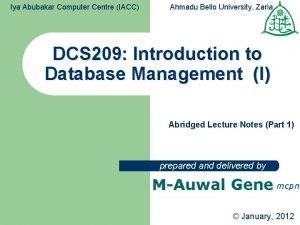The Quiet Skies Project and the IYA Ronald

- Slides: 1

The Quiet Skies Project and the IYA Ronald J Maddalena, and Sue Ann Heatherly National Radio Astronomy Observatory Green Bank, WV Introducing the Quiet Skies Project Astronomers need dark skies to see the stars, but did you know they also need quiet skies? Learn more about radio astronomy, and the noisy world we live in by participating in the Quiet Skies Project. In the same way that man-made light obscures our night sky and blinds ground-based optical telescopes, man-made radio signals effectively blind radio telescopes as well. You’ve heard of light pollution– now think radio pollution*! We’d like to introduce you to your noisy world and the challenges astronomers face in trying to investigate the radio universe. Join in a global effort to determine just how quiet your skies are, by measuring radio pollution in your community! * Astronomers call radio pollution “Radio Frequency Interference” or RFI. Where’s the astronomical signal in this typical radio spectrum? Everything in this plot is RFI except for the tiny line at 1420 MHz which arises from hydrogen in our Milky Way. Yet, this is one of the strongest radio spectral lines and an important astronomical probe of the interstellar medium. Get Involved! 1. Be an RFI Detective in your home, or lead an activity in your school or museum. Using a simple portable AM radio, search for sources of RFI. You can audibly detect RFI from small motors, computers, remote control devices, light switches… you’ll be amazed at what you find! This is a great activity for younger scientists! Visit http: //www. quietskies. org to download the activity handout. Background: Clockwise from top left: Green Bank Telescope, Parkes Telescope, Artist’s conception of ALMA, Radio Galaxy Fornax A 2. Make measurements and report the results to the Quiet Skies Database! You have 2 ways to go: • Use a laptop and a WIFI card to measure RFI from wireless access points using cool free software! At right, a screen shot of the Xirrus WIFI widget. This is free and works with Windows, Mac and Linux. There’s more to the universe than meets the eye. Gigantic radio telescopes all over the world study cosmic objects that emit radio waves. Some of the objects may sound familiar: comets, nebulae and galaxies to name a few. Radio astronomers also observe signals from some of the most extreme objects in the universe— like neutron stars and black holes, and some of the most extreme events —like the Big Bang! These signals are weak by the time they reach Earth having traveled enormous distances. Your cell phone detects radio signals that are 1/100 th of a watt, radio telescopes detect signals that are 1/1000000000000000 th of a watt in in strength! That’s why radio astronomers need quiet skies. The National Radio Astronomy Observatory is a facility of the National Science Foundation, operated under cooperative agreement by Associated Universities, Inc. • Fifty Quiet Skies Detectors are available for loan to museums, schools, and clubs in the U. S. for those who want to do activities with students and informal groups. With the Quiet Skies Detectors, you’ll be making measurements at frequencies that are important to astronomers. These sensitive detectors were designed by engineers and scientists at the National Radio Astronomy Observatory. The Database RFI data logged into the Quiet Skies Database will be used to create an interactive global map showing the extent of radio pollution. Students measure RFI in Green Bank, WV. More Info? For more information visit www. quietskies. org, or contact Sue Ann Heatherly, at sheather@nrao. edu. Ph: 304. 456. 2209

